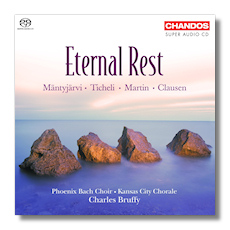
The Internet's Premier Classical Music Source
Related Links
- Martin Reviews
- Latest Reviews
- More Reviews
-
By Composer
-
Collections
DVD & Blu-ray
Books
Concert Reviews
Articles/Interviews
Software
Audio
Search Amazon
Recommended Links
Site News
 SACD Review
SACD Review
Eternal Rest

Choral Works
- Jaakko Mäntyjärvi: Canticum Calamitatis Maritimae
- Frank Ticheli: There Will be Rest
- Frank Martin: Mass for Double Choir
- René Clausen: In Pace
Phoenix Bach Choir
Kansas City Chorale/Charles Bruffy
Chandos CHSA5045 Hybrid Multichannel SACD 59:49
Summary for the Busy Executive: Ambitious.
As a choral director, Charles Bruffy comes from the Robert Shaw wing. He gets a beautiful sound from his choirs, due to an emphasis on choral uniformity of vowels. His groups, like the defunct Dale Warland Singers, tend to emphasize the tough and the contemporary.
I might as well get the basic stuff out of the way: this is a fine CD, judged by the highest standard. Serious music – at least one classic – receives beautiful performances. As far as the program goes, only one piece, René Clausen's In Pace, falls short of the standard Bruffy sets everywhere else. There's nothing wrong with it. It's just a "choir-master" piece, with little other than smooth part-writing to recommend it. Clausen, director of the Concordia College Choir in Minnesota, has written a sleigh-load of similar works for college and church groups.
My favorite new work is the Finn Jaakko Mäntyjärvi's Canticum Calamitatis Maritimae ("song of the maritime disaster"), based on the loss of more than 900 lives on a cruise ship that went down heading from Estonia to Sweden in the Eighties. An imaginative compendium of contemporary techniques, the Canticum rises above them. It begins with a solo soprano wordlessly spinning out a folk-like melismata over freely-whispered prayers. The men enter on open fifths, and a solo tenor recites, in a line strongly reminiscent of Gregorian chant, the circumstances of the disaster. So far, if I had to compare it to any other music, I'd pick Veljo Tormis or one of the other Baltic Holy Minimalist masters. Then comes a long setting of Psalm 107 ("They that go down to the sea in ships"), and all that goes out the window. Mäntyjärvi reveals himself as a neo-Modernist like his countryman Rautavaara, but more folk-like and diatonic, with a fondness for beautiful chord progressions. The piece ends as it began, with the ecstatic solo soprano line over whispered prayers.
Frank Ticheli, who teaches at USC, is best-known for his band and orchestral pieces. Nevertheless, There Will be Rest, which sets a Sara Teasdale lyric, has become a recent choral hit. The writing has a family look to Morten Lauridsen's, but it's pretty enough to stand on its own. It follows the poem with great care for the poem's phrasing and with sensitivity to meaning.
The big piece on the program, Frank Martin's Mass for double choir, after years of neglect due to the composer's hiding it in a drawer, has quickly established itself as a repertory touchstone. My favorite performance comes from the Dale Warland Singers (American Choral Catalogue 120). It takes a great choir just to get through the work, let alone get through it with grace. Bruffy and his singers do a good job – superb intonation and beautiful blend. If they disappoint slightly, it's because I compare them to Warland's account. Diction tends to run to the vague, with little color variety in the tone.
I also pick nits with Chandos's engineering. Sure, it's a beautiful sound, but in the Martin, it's a blob of beautiful sound. One doesn't often get the sharp image of two choirs playing off one another. The engineers do much better with the Canticum.
Copyright © 2008, Steve Schwartz




















